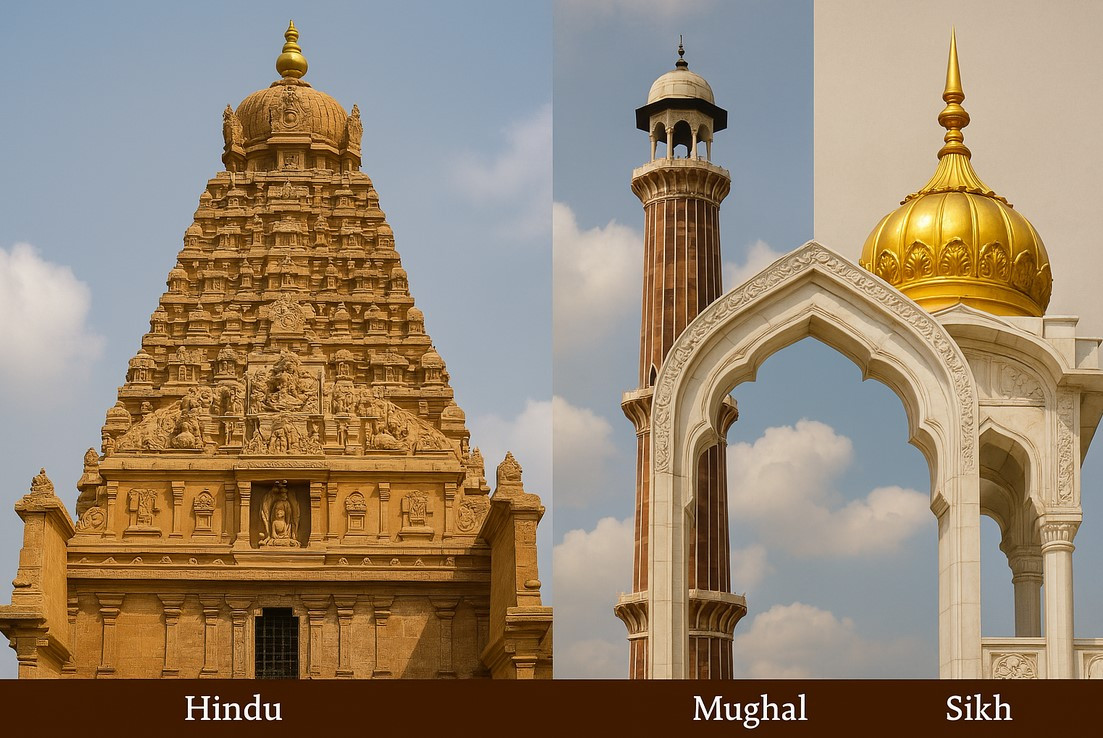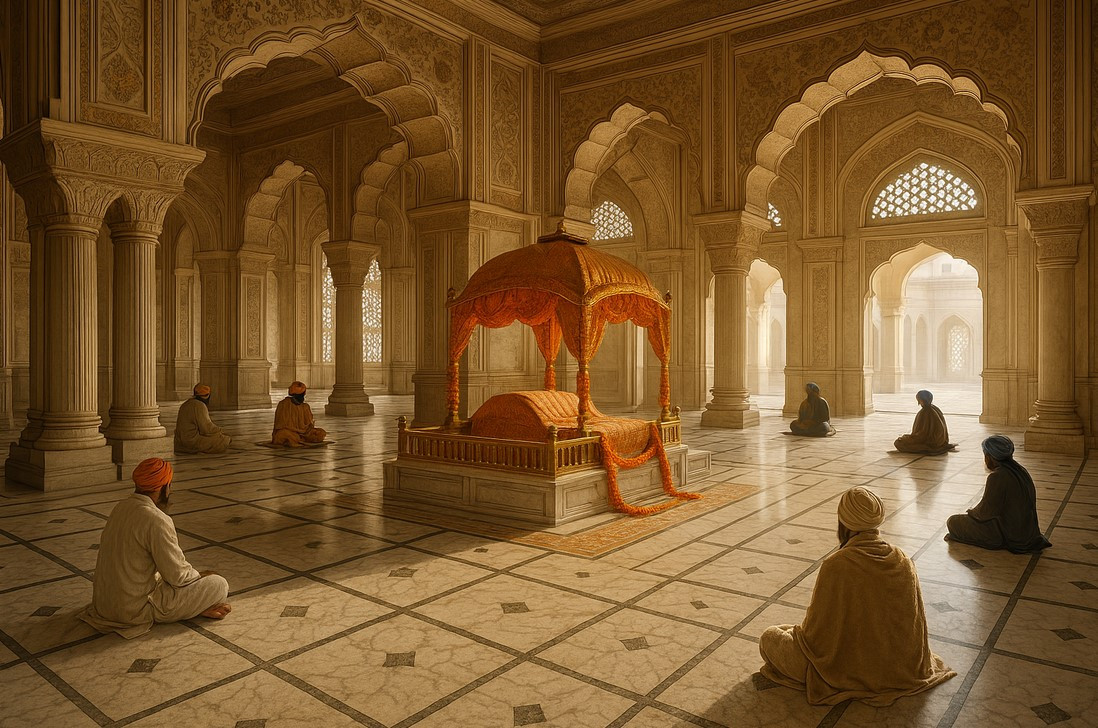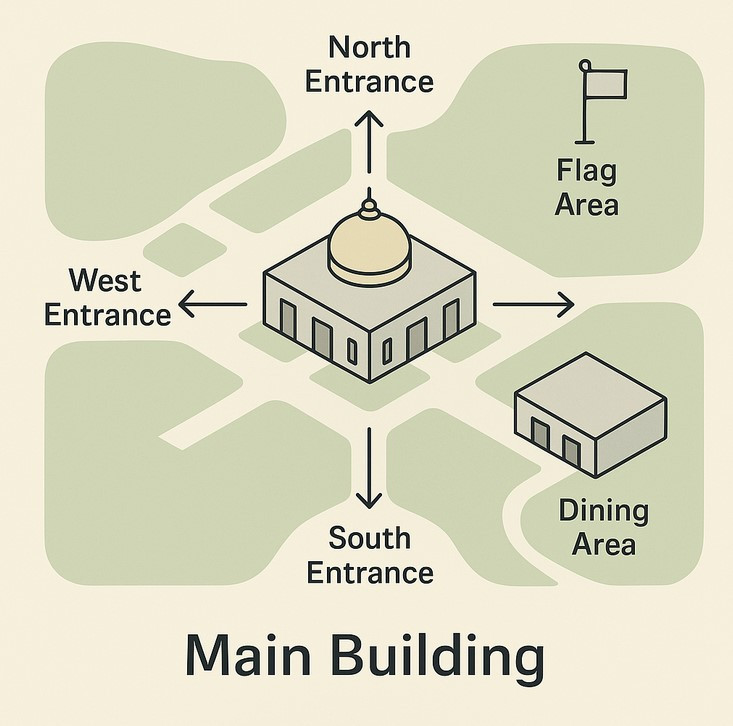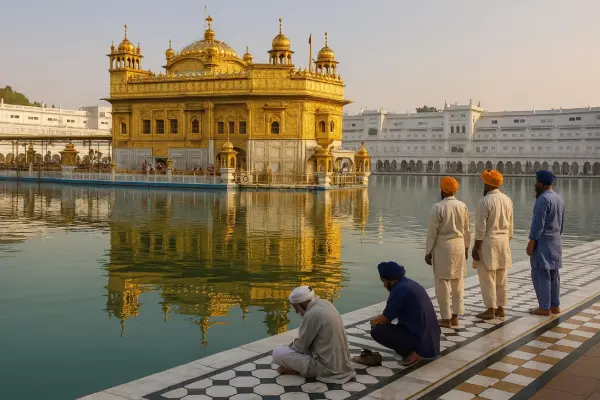Sikh architecture represents a unique phenomenon in the history of Indian architecture, formed in Punjab during the period of the Sikh state's existence in the 16th-19th centuries. The architectural style of Sikhism reflects the deep spiritual principles of this religion, which emerged in northern India and combines elements of various cultural traditions. In this article, we will examine the features of Sikh architecture, the history of its development, and the most significant Sikh temple complexes.
Origins and Influences on the Development of Sikh Architecture
The history of Sikh architectural traditions is inextricably linked with the development of Sikhism itself. The architecture of gurdwaras (Sikh temples) incorporated features of Hindu and Mughal architectural traditions, refracting them through the prism of Guru Nanak's teachings - a monotheistic religion that emerged in Punjab in the 15th century. From Hinduism, the architecture of Sikhism's followers borrowed temple-building traditions but adapted them to the needs of Sikh worship. From Mughal architecture, the Sikhs adopted an inclination toward monumentality and decorative embellishment.
 The Indo-Islamic style had a significant influence on the formation of Sikhism's architectural style. Mughal influence and elements of Indian temple tradition can be traced in the use of arches, domes, and complex geometric patterns. At the same time, Sikh architectural traditions gave these elements new symbolic meaning. Research shows that from the 16th to the 19th century, Islamic architecture had a decisive impact on the development of Sikh temple complexes in the Punjab region[1]. In this process, the Kara community - traditional builders and craftsmen who preserved and developed unique architectural techniques - played a significant role.
The Indo-Islamic style had a significant influence on the formation of Sikhism's architectural style. Mughal influence and elements of Indian temple tradition can be traced in the use of arches, domes, and complex geometric patterns. At the same time, Sikh architectural traditions gave these elements new symbolic meaning. Research shows that from the 16th to the 19th century, Islamic architecture had a decisive impact on the development of Sikh temple complexes in the Punjab region[1]. In this process, the Kara community - traditional builders and craftsmen who preserved and developed unique architectural techniques - played a significant role.
"Sikh architecture is an amazing example of cultural synthesis, where different architectural languages merge into a single harmonious whole. In each element of a gurdwara, one can see the reflection of Sikhism's openness and its aspiration to unite different traditions while maintaining its own identity." — Prem Singh Gill, Professor of Architecture at Punjab University
Main Features of Sikh Architecture
The main characteristic of Sikh architecture is its close connection with religious cult. All significant Sikh structures are in one way or another connected with their faith, and Sikh religious buildings reflect the basic principles of the teaching.
Gurdwaras — Centers of Sikh Architecture
 The most important element of Sikh temple construction is the gurdwara - temple-tombs of Sikh gurus. The architecture of gurdwaras in India is characterized by lavish decoration of facades and interiors. Their decoration combines Hindu and Muslim motifs, creating a unique architectural language using traditional elements such as parkara (decorative framing of domes) and deori (entrance pavilions with arches).
The most important element of Sikh temple construction is the gurdwara - temple-tombs of Sikh gurus. The architecture of gurdwaras in India is characterized by lavish decoration of facades and interiors. Their decoration combines Hindu and Muslim motifs, creating a unique architectural language using traditional elements such as parkara (decorative framing of domes) and deori (entrance pavilions with arches).
The domes of Sikh temples are their most recognizable feature. They are often covered with gold, as in the case of the main Sikh shrine in Amritsar. Especially notable is the Gurdwara Bangla Sahib in Delhi with its snow-white marble facade and majestic gilded domes, which has become a model for many modern Sikh spiritual centers. The use of marble and gold in temple decoration symbolizes purity and divine light. The symbolism in gurdwara design is closely connected with the teachings of Sikhism and has deep spiritual significance.
Traditional elements of Sikh architecture include:
- Four entrances to the temple, symbolizing openness to people of all castes and beliefs
- The Amrit Sarovar (sacred pond) around the main temple building
- Langar hall in gurdwaras — a kitchen and dining area for free distribution of food
- Nishan Sahib — the flag of Sikhism, installed in front of each temple
- Darbar Sahib — the main prayer hall, where the Guru Granth Sahib (sacred book) is placed
Many of these elements have not only religious but also social significance, emphasizing the principles of equality and service to society, which are central to Sikhism.
Defensive Architecture in Sikh Construction
Another characteristic feature of Sikh architecture is defensive construction. Many Sikh temple complexes were surrounded by powerful walls with towers and functioned as fortresses. This is related to the historical context of Sikhism's formation, when Sikhs had to defend themselves from persecution.
Sikh forts and fortresses, such as Annapurna and other fortifications, represent an important aspect of Sikh architectural heritage. The architectural ensemble of Akal Takht in Amritsar was initially built as a military-administrative center.
A striking example of Sikh defensive architecture is the Golden Temple of Amritsar, surrounded by a water moat and wall. The temple complex houses the Bunga Ramgarhia — a three-story watchtower built to protect the shrine.

| Architectural Element | Description | Symbolic Meaning |
|---|---|---|
| Domes and spires | Onion-shaped, often covered with gold or white marble | Connection between heaven and earth, spiritual aspiration |
| Gurdwara Bangla Sahib | Snow-white walls with golden domes | Purity of spirit and divine light |
| Four entrances (char-dwar) | Entrances from the four cardinal directions | Openness to all, regardless of caste, religion, or gender |
| Saraswati-niwas | Prayer halls with open space | Equality of all believers before God |
| Jaratkari | Technique of inlaying colored stones in marble | Diversity in unity, divine beauty |
| Chaurrasi | Sikh memorial structures | Memory of martyrs and Sikh gurus |
This table illustrates how architectural elements in Sikh temples are closely connected with religious symbolism and spiritual concepts of Sikhism. Each element has not only aesthetic but also deep philosophical function.
Major Monuments of Sikh Architecture
Among the masterpieces of Sikh temple architecture, the following Sikh temple complexes can be highlighted, which annually attract pilgrims and tourists from around the world:
- Harmandir Sahib (Golden Temple) in Amritsar — the central temple complex of Sikhism, the place where the sacred text Guru Granth Sahib is kept. The history of the Golden Temple construction began in 1588 on the initiative of Guru Arjan Dev. This architectural masterpiece is considered one of the most striking examples of Indo-Islamic architectural synthesis[2], combining elements of Indian and Islamic traditions. Tours of the Golden Temple are conducted daily, providing an opportunity to learn about the technologies of dome gilding and other features of this unique monument.
- Gurdwara Bangla Sahib in Delhi — one of the most famous Sikh temples, with its characteristic white marble facade and golden domes, is an important point on the tour of Sikh temples in India.
- Gurdwara Janam Asthan in Nankana Sahib — a memorial complex dedicated to the birth of Sikhism's founder, Guru Nanak.
- Gurdwara Pattan — a gigantic temple complex with gilded domes, demonstrating the monumentality of Sikh architecture.
- Fort Govindgarh — a powerful fortress in Amritsar, built by Ranjit Singh, representing the military aspect of Sikh architecture and included among the significant Sikh forts and fortresses of the region.
"When I first visited Harmandir Sahib, I was struck not only by the magnificence of the architecture but also by the atmosphere of peace and unity. The temple, reflected in the sacred pond, creates an illusion of hovering between heaven and earth. This is a place where architecture becomes a conductor of spiritual experience." — Richard Armstrong, architect and researcher of religious architecture
Modern Development of Sikh Architecture
 The modern architecture of Sikh temple structures continues to develop, preserving traditional elements but adapting them to modern requirements and technologies. Modern gurdwaras outside India, in countries with large Sikh diasporas (USA, Canada, Great Britain), often combine traditional elements with contemporary architectural solutions.
The modern architecture of Sikh temple structures continues to develop, preserving traditional elements but adapting them to modern requirements and technologies. Modern gurdwaras outside India, in countries with large Sikh diasporas (USA, Canada, Great Britain), often combine traditional elements with contemporary architectural solutions.
Sikh architectural traditions also influence secular construction in regions with significant Sikh populations. Punjabi architecture today includes many elements that came from the Sikh tradition. Sikh motifs in public architecture are manifested in the design of educational institutions, cultural centers, and even commercial buildings. The eco-architecture of modern gurdwaras reflects ecological principles important for contemporary society.
In recent decades, much attention has been paid to the restoration of Sikh monuments, especially those that suffered during times of religious conflicts. Technologies for dome gilding and other traditional construction techniques are preserved and passed on to new generations of craftsmen. In some centers, master classes are conducted on Sikh calligraphy and traditional crafts related to temple decoration, and in souvenir shops at large gurdwaras, one can purchase souvenirs in the style of Sikh architecture — from miniature copies of famous temples to interior items with traditional ornaments.
Success Story: Restoration of Sikh Architectural Heritage in Pakistan
The amazing story of the restoration of Gurdwara Dera Sahib in Lahore has become an example of interfaith cooperation. In 2019, after decades of desolation, the historic gurdwara associated with the fifth Sikh guru, Arjan Dev, was restored through the joint efforts of Pakistani and Indian restorers. Local Muslim craftsmen worked together with Sikh specialists, restoring lost architectural elements based on historical photographs and documents. The restoration of the golden dome and marble inlay was carried out using traditional techniques that were nearly lost. Today, Gurdwara Dera Sahib has not only become an important monument of Sikh architecture in Pakistan but also a symbol of the possibility of preserving cultural heritage beyond political disagreements.
Sikh architecture in Pakistan is also represented by other significant structures, such as the Panja Sahib complex in Hassan Abdal and Gurdwara Sahib in Kartarpur — the place where Guru Nanak spent the last years of his life. These monuments, along with other Sikh temple complexes on the territory of modern Pakistan, form an important pilgrimage route to Sikh shrines and attract thousands of believers annually.
"The architecture of gurdwaras is not just construction art; it is the visual embodiment of the principle of 'Ek Onkar' — the unity of being. When you see how temples combine elements of different cultures, how they are open to all people, you understand that the building itself is a sermon on unity and equality." — Gurcharan Kaur, specialist in Sikh culture
Conclusion
Thus, the architectural traditions of Sikhs occupy a special place in the history of Indian architecture, reflecting the uniqueness of Sikh religion and culture. The prayer complexes of Guru Nanak's followers in India and beyond represent a unique synthesis of various traditions united by the philosophy of Sikhism. The features of Sikh architecture, such as monumentality, richness of decoration, symbolic significance of each element, and the combination of religious and defensive functions, make it an important cultural phenomenon.
The history of Sikh temple construction continues to develop today, preserving traditional elements in combination with modern technologies. The map of Sikh temples covers not only India and Pakistan but also many countries of the world where Sikh communities exist. Visiting the gurdwaras of Punjab remains one of the most important destinations for religious pilgrimage, and the pearl of Punjabi architecture — Harmandir Sahib — is considered an outstanding monument of world architecture, attracting tourists and believers from around the world.
Recommended literature in English for in-depth study of Sikh architecture:
- Singh, P., & Fenech, L. E. (2014). The Oxford Handbook of Sikh Studies. Oxford University Press.
- Brown, K. (1999). Sikh Art and Literature. Routledge.
- Murphy, A. (2012). The Materiality of the Past: History and Representation in Sikh Tradition. Oxford University Press.
- Arshi, P. S. (1989). The Golden Temple: History, Art and Architecture. Harman Publishing House.
- Stronge, S. (1999). The Arts of the Sikh Kingdoms. V&A Publications.
- Grewal, J. S. (2019). Guru Nanak in History. Oxford University Press.

